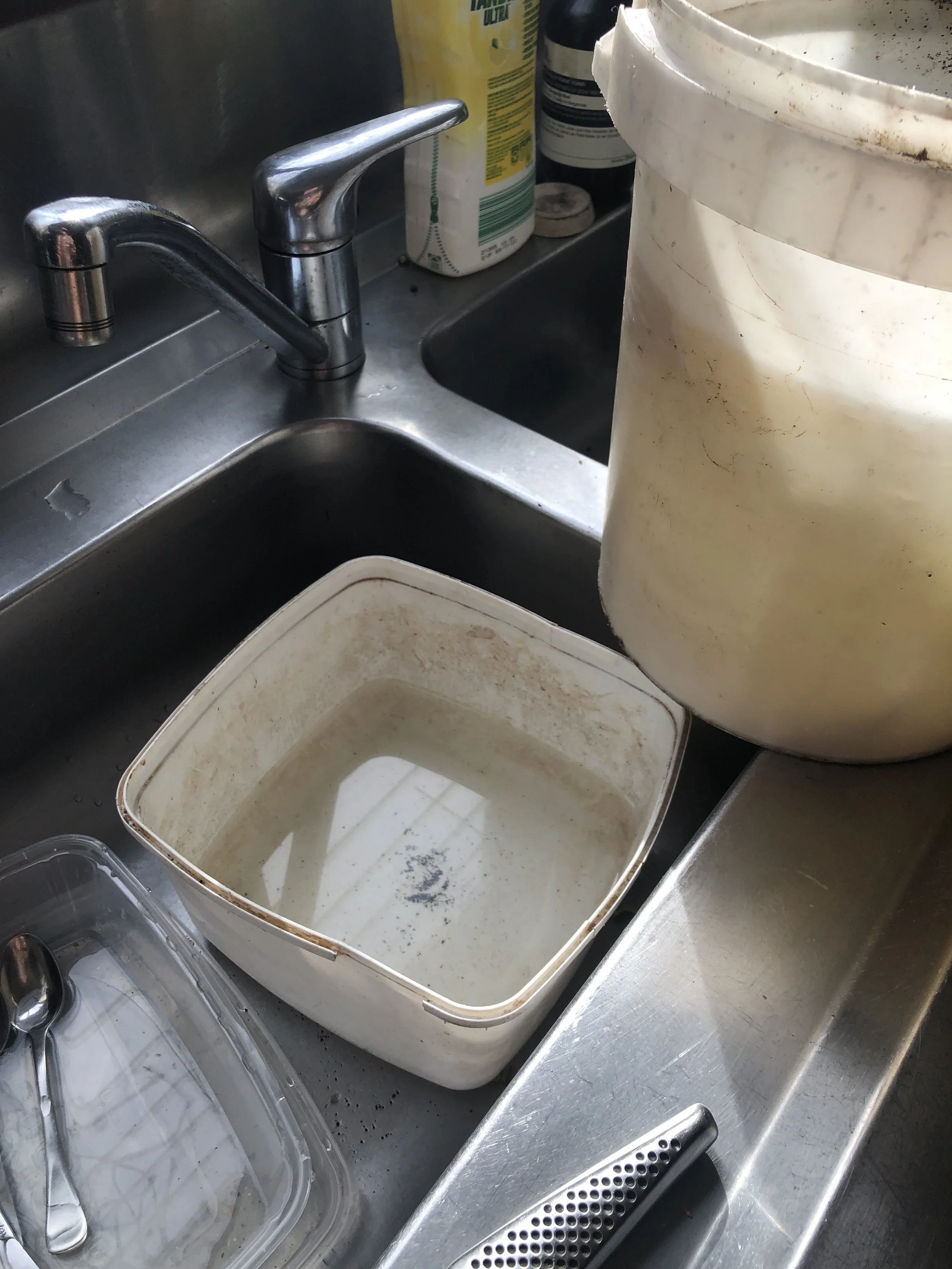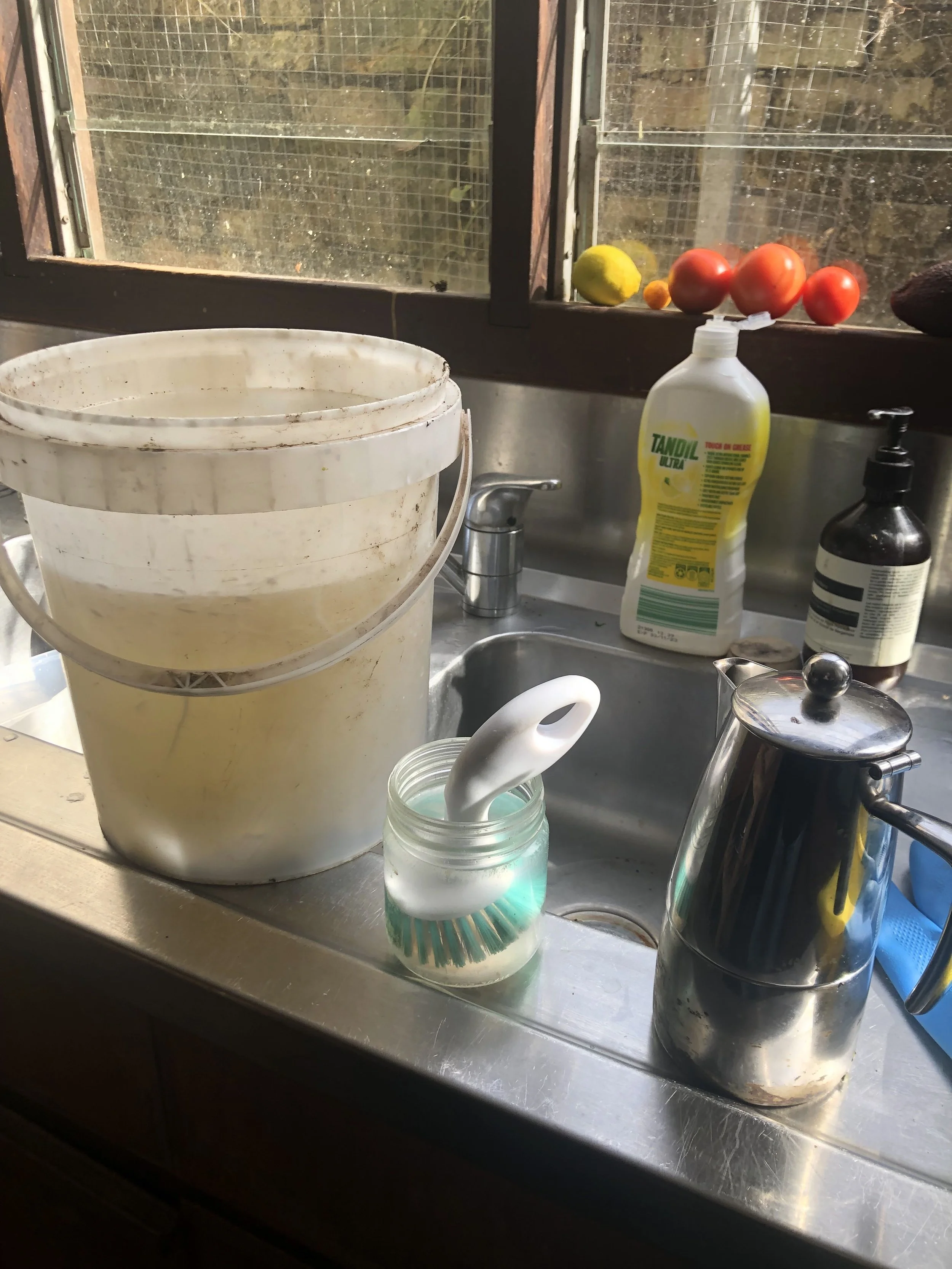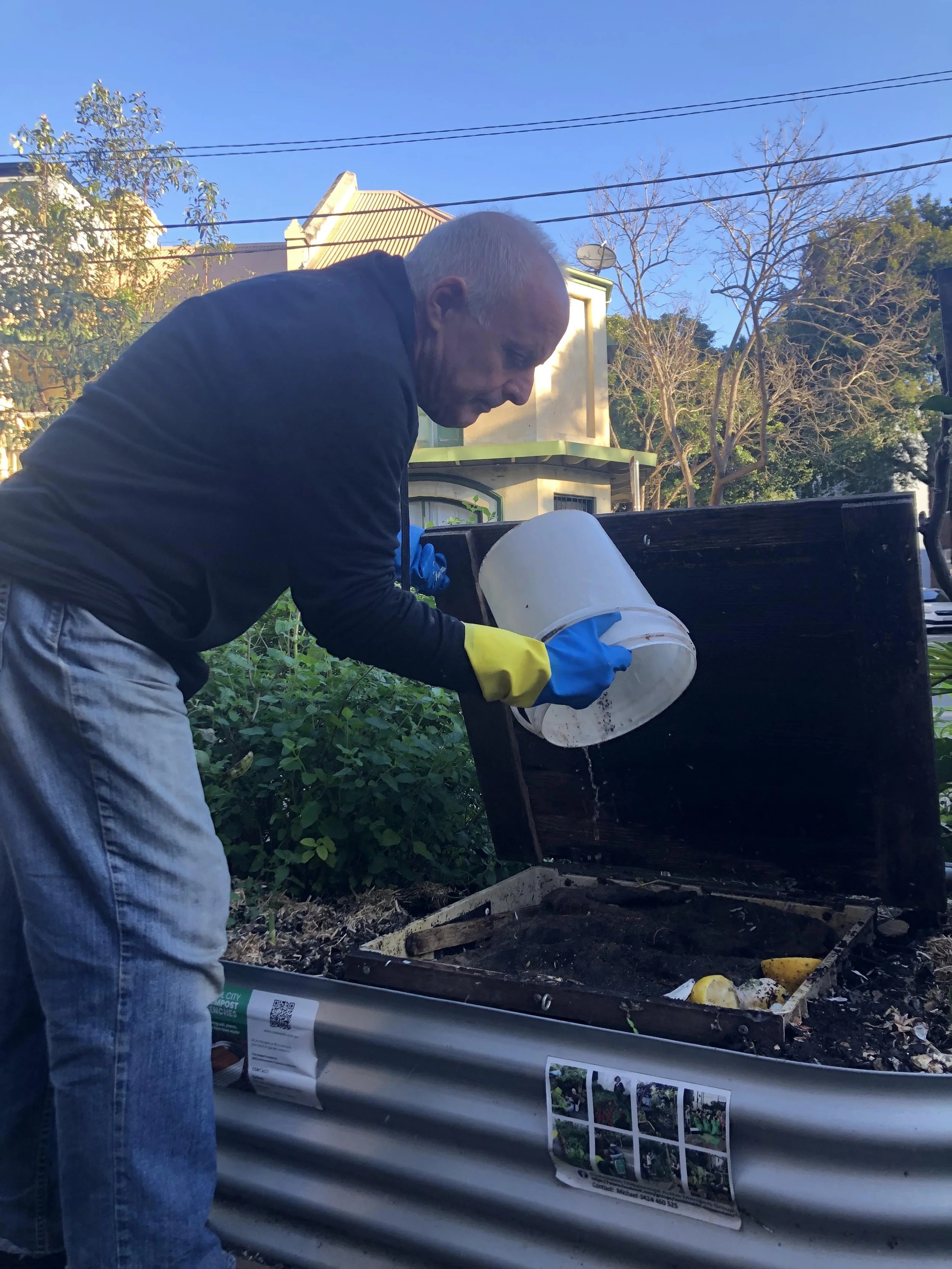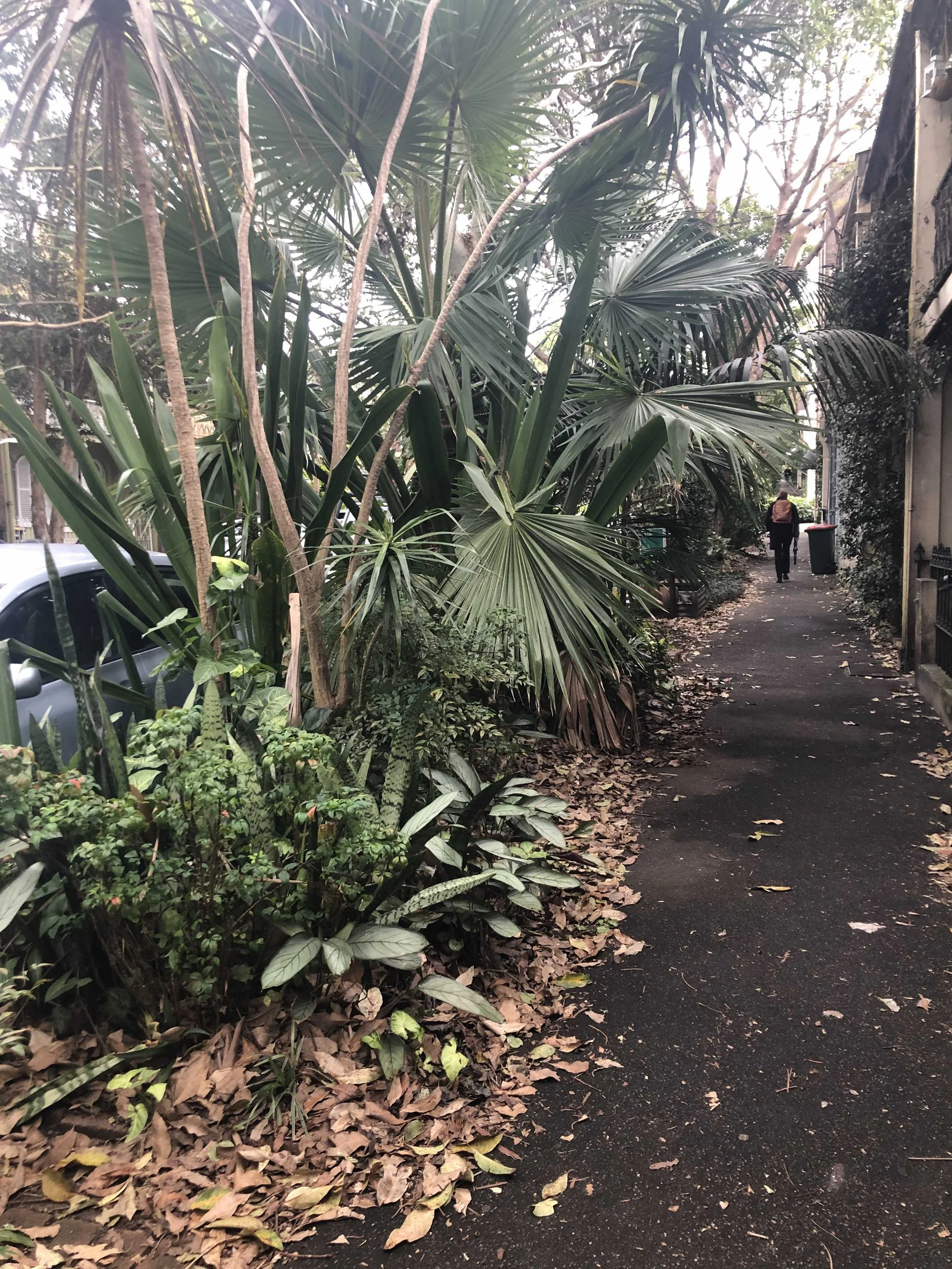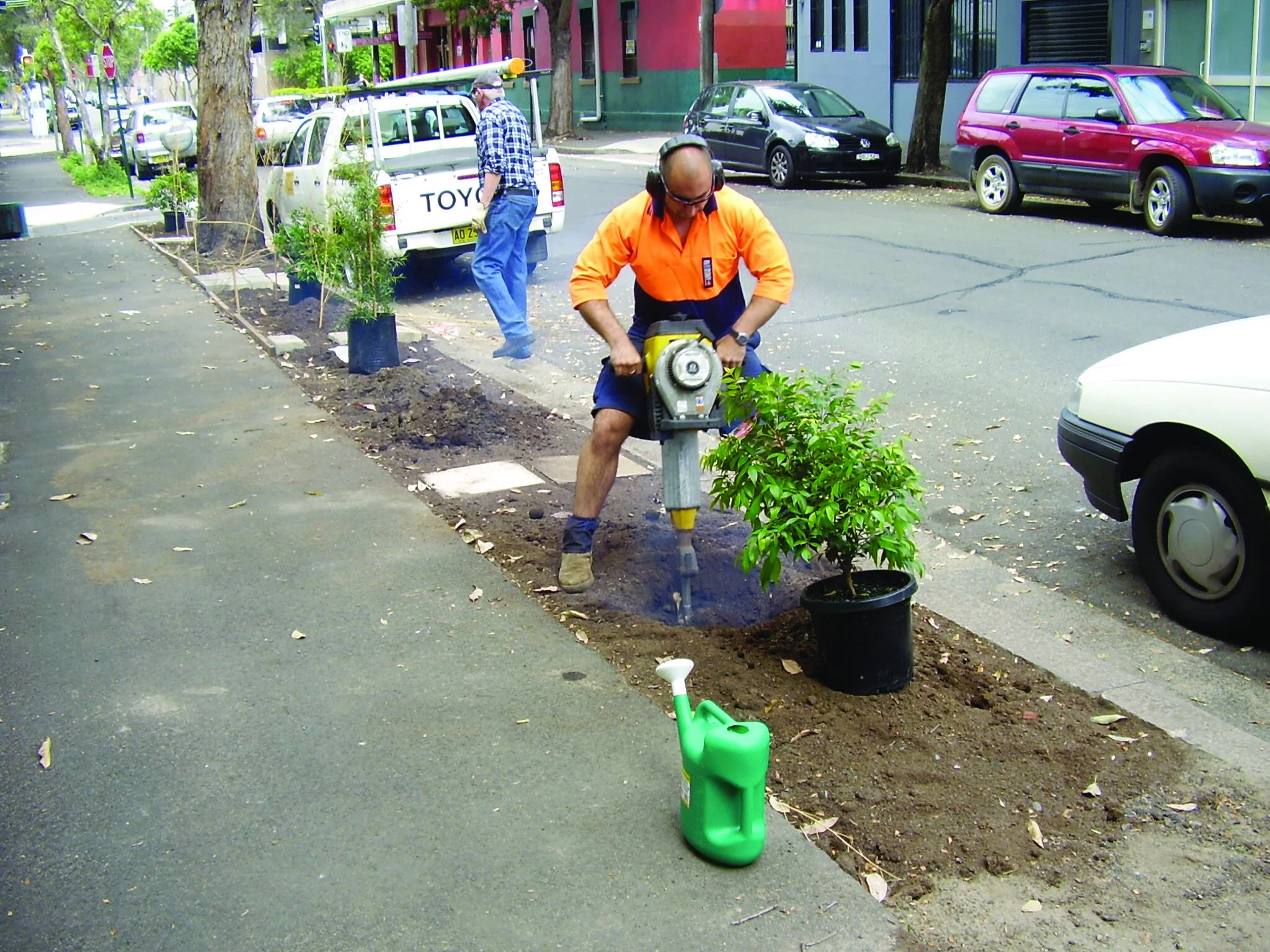• From sink water to beauty
Here’s how to get a greener street from your kitchen sink, and blokes.
We can turn our household ugly duckling – our dish water - into public beauty, trees and plants that are bigger and healthier.
If my kitchen sink is any guide we Australians typically use around 10 to 20 litres of water to prepare a meal and to wash up afterwards.
I know that from my own cooking.
A two litre used ice cream container, and a 6 litre used yoghurt container stay in my two sinks. This is their story. The role of blokes – males in the kitchen – is part of the story.
Water to wash veggies and dishes goes into the two containers. Vegie off-cuts (which don’t get used to make soup stock), cooking and plate scrapings go in, too. So do coffee grounds and tea leaves.
• 6 litre container, coffee percolator
The mixed water and food scraps are emptied on the Chippendale road verge gardens outside the house. Typically the 6 litre container is emptied twice to four times a day depending on what’s cooked and how many people eat.
Liquid from the container is strained through our gloved fingers onto the plants and trees.
• Straining dishwater onto a raised bed garden on the road verge
The remaining veggie scraps go into the community compost bins and coolseats – seats that are composts - in our streets.
• Food scraps, coffee grounds going into a coolseat on the road verge
Dishwater increases tree and plant growth in our Chippendale streets, and helps grow compost to fertilise the gardens
Does this revolt you?
• Lush road garden in the street outside my house. Australian road design diverts rain away from the road verge and stunts plant and tree growth, heats up the road. Chippendale road gardens counteract poor road design and keep the rain where it falls. Dishwater helps, too.
• In 2006 soil in our street verges was rock hard, lifeless; during a community street gardening day a Council worker working with us (residents and businesses) had to use a jackhammer to dig a hole for trees
Compare the two photos above.
The dishwater doesn’t revolt our street trees and plants. They flourish because the soil has water and nutrients.
The sewage your Sydney dish water mixes with goes untreated, raw, into the harbour and ocean.
Dish water and food scraps do revolt the fish, little critters and plants in Sydney harbour, Botany Bay and the ocean off Sydney Harbour.
The city’s 4.8 million humans send their dishwater from their 1,623,868 households into the fishes’ breathed-in-water.
Next time you eat some fish imagine where it swam and what was in the water.
About 60% of fish sold in Sydney’s fish markets are caught off the Australian coast where our cities and farms drain their waste water from sinks, toilets, showers, dishwashers, paddocks and roads.
Sewage is ‘treated’, not to protect the fish or sea life but to keep the sewage flowing out to sea. The only ‘treatment’ the state government gives it is to remove solid objects and some heavy grease.
Big objects and heavy grease are removed so the sewage will not clog up holes in the buried outlet pipes through which the sewage is pumped directly into the ocean off the city. The state government owns Sydney’s water and sewage business and licenses its own pollution from its ocean sewer outfalls. Hidden, underwater pollution from the state business destroys water quality and fish life in the ocean.
Each year the government puts some 380,000 megalitres of mixed dishwater and sewage into the ocean.
One megalitre is 1 million litres; an Olympic size swimming pool is 1 million litres.
So each year the ocean and the fish life in it beside Sydney gets 380,000 Olympic sized swimming pools of excreta, including dish water, or over 1,000 swimming pools of excreta each day go where fish live.
(No sewage, including dishwater, has left my Chippendale house since 1996 when the house was disconnected from town water and sewer, 26 years ago. If you don’t know about the house, or don’t believe me - Sydney Water didn’t until they checked - please come on one of the house tours and have a look.)
Here are my estimates of dish water that’s going with sewage each day into Sydney harbour, and the Pacific ocean beside it, and are made using population figures from the Australian Bureau of Statistics:
If one person’s dishwater per meal is 2 litres, that’s 28,943,946 litres per day. If it’s 6 litres per person, that’s 86,832,838 litres a day. Or, between 28 to 86 Olympic size swimming pools a day of dishwater.
Number of people in Sydney: 4,823,991
- families - 1,247,047
- average number of people per family 2.82
- dwellings – 1,623,868
The dish water we put in our Chippendale streets, however, grows plants and trees to cool the street and create beauty. That lush vegetation increases the value of the properties and cools the streets on hot summer days and nights. We’ve measured the temperature difference. On a 40 degree day our streets measure less than 30 degrees, ten 10 degrees cooler because of the road gardens and the shade there.
The worms and little critters in the compost grow rich soil and we add it to the Chippendale street gardens to increase fertility and to grow trees and plants there.
But wait, there’s more.
If you’re not curious, or are from the city, not the country and a farm upbringing (as am I) what I do in my kitchen may be confronting and I accept that. By growing up on a farm I learned to live with shifting baselines, the floods, droughts, life and death of animals and all that lives and dies and changes in the country. For example, I was encouraged as a boy to wee on the soil around fruit trees.
David Attenborough writes about his experiences with shifting baselines in his book and documentary, A life on Earth; it’s where “each new generation perceives the environmental conditions in which they grew up as ‘normal’“.
What I describe here is about blokes in the kitchen. Our wee. (I may lose some of you at this point but here goes. I prefer this solution to putting my excreta into the water - sewage that goes into the ocean - where the fish and little critters breath and live.)
What I do is only my choice and I’m not saying others should do what I do; I just blog and write about actions and projects and invite any feedback, differences, comments anyone may wish to offer; what works for one person doesn’t work for another or for everyone, of course.
Let’s understand our human urine: Wikipedia says:
“Urine plays an important role in the earth's nitrogen cycle. In balanced ecosystems, urine fertilizes the soil and thus helps plants to grow. Therefore, urine can be used as a fertilizer. Some animals use it to mark their territories. Historically, aged or fermented urine (known as lant) was also used for gunpowder production, household cleaning, tanning of leather and dyeing of textiles.“
Whether you do as I do, described below, it’s prudent to keep an eye on the colour of your urine as, Wikipedia says:
“The color and volume of urine can be reliable indicators of hydration level. Clear and copious urine is generally a sign of adequate hydration. Dark urine is a sign of dehydration. The exception occurs when diuretics are consumed, in which case urine can be clear and copious and the person still be dehydrated.”
Ok, here it is.
I wee in the ice cream container or 6 litre bucket and it mixes with the dish water. (Got to show love and respect for our ocean and the precious life there, right?)
(No action photos available yet.)
There’s a strong argument for males doing the dishes because it’s easier for blokes to wee into sink buckets than females.
Like you, male and female alike, I’m a walking fertiliser factory.
My urine in the dishwater increases its fertilising benefits to grow plants and trees.
Human urine has nitrogen and phosphorus in it, so it’s an excellent garden fertiliser. And the oceans don’t need it; so much goes into oceans worldwide that they’re becoming acidic and killing places like the Great Barrier Reef.
Urea is the nitrogen in our human urine. Each day there’s about 10 grams of urea, and about 1 gram of phosphorous in our urine.
We can waste our urine and buy nitrogen as urea fertiliser from garden and farm shops to put in our gardens. In Sydney most of the 4.8 million humans do waste and excrete it into toilets to go into the ocean (and fish).
Each day about 100 tonnes of nitrogen is in the sewage from Sydney and Melbourne.
Companies manufacture nitrogen, too. In June 2022 urea was selling on the international market for $690 a metric tonne.
“ The amount of energy spent in the manufacturing of urea is equivalent to emissions created by the global aviation industry”, says University of Melbourne chemical engineer, Dr Stefano Freguia. “It makes up about 2 per cent of the worldwide energy consumption which is mostly fossil fuel driven and so it contributes to global warming and greenhouse gas emissions.”
Due to our human (temporary) ‘dominance’ of all that’s now on Earth’s land and oceans, whatever our reaction to our own excreta and how to take steps to stop ourselves damaging Earth, the oceans and soils here, we now unwittingly ingest our own waste.
Each year now, for example, we humans ingest a teaspoon or so of microplastics from the food we eat, including seafood.
Of course, the other contributors to fertilising our road gardens are the many dogs who clearly give a woof about this by weeing on the parks, road gardens, too. Thank you, dogs and dishwater and blokes who wee in it.
And, thank you, Earth - I love you and do my best for you and all here.
Michael


